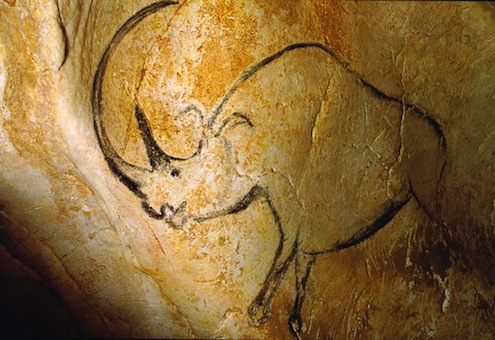Whenever there is a succession of 3-D films, you know Hollywood is in trouble. When the studio system was in its dotage during the 1950s, before the industry knew enough to rejuvenate itself by handing over the keys to the motorcycle to Easy Riders and other wild-eyed independents, it relied on 3-D to fill the coffers. Right now, the Dream Factory in California is located more in Silicon Valley than Hollywood. Science fiction no longer predicts science as the technology sector has the better ideas. And the movie industry responds with an over-reliance on gimmicks.
While the hunger for 3-D has abated somewhat in America, the world market has yet been satisfied, so even the mad genius auteur Werner Herzog has been given the opportunity to work with the effect in Cave of Forgotten Dreams. The film is an exploration of the Chauvet Cave in Southern France, which was discovered in 1994 by Eliette Brunel-Deschamps, Christian Hillaire, and Jean-Marie Chauvet. It bears the most historical artwork known to humankind on its walls, elaborate drawings of megafauna, human beings and creatures that combine the two, which were made at least 32,000 years ago. But Cave of Forgotten Dreams isn’t a mere art-history documentary, but rather a tacit struggle between Herzog and the 3-D illusion itself, which has a knack for directing directors, for wrestling the story from their hands.
It’s not completely a fair fight, either. Herzog not only has to deal with technical necessities of 3-D but is also hampered by the fragility of the cave, which demands that Herzog work from bended knee (sometimes in a metaphorical sense, sometimes not), not use too many cameras or lights, not get too close, not get his hands dirty. Whether he has been running headlong into the maw of a bubbling volcano (“La Soufriere”) or dragging a riverboat over a mountain into the jungle (Fitzcarraldo), Herzog is no stranger to obstructions forming his art. He is, however, alien to not being allowed to challenge the elements and having to genuflect in awe rather than form an adversarial relationship.
Making this movie for History Films (a subsidiary of the History Channel) has its restrictions, too. In addition to being a great artist, Herzog is a canny journalist, asking questions others wouldn’t pose, tugging at loose threads that most would never notice. His films are amazing as much for his powers of observation as for his daring. In one scene the director interviews an archaeologist who used to be a circus man. A scene that would have been a long and fascinating digression in a usual Herzog film is instead glossed over in favor of more standard storytelling, a concession that seemingly was made for the producers.
That’s the overall tone of the film: handsome and reverential with the requisite 3D-motion shots, but not Herzogian, lacking his insane brilliance. Until the five-minute “Postscript” section, that is. Herzog discovers a nuclear power plant less than 20 miles from the priceless cave. A second startling discovery is a nearby greenhouse that uses the warm water runoff from the power plant to grow hothouse flowers and allow albino crocodiles to thrive. The past, the present and the future unite against odd scenes of ferocious reptiles in an almost operatic way. The Herzog magic emerges in these moments, and we see the wry storytelling and resourcefulness that always restores Hollywood once its gimmicks run aground. In these scenes, Herzog’s been able to traverse one of the biggest obstacles of his career, one that is more ominous than a volcano or jungle–technology itself.•
You are currently browsing articles tagged Jean-Marie Chauvet.
Tags: Christian Hillaire, Eliette Brunel-Deschamps, Jean-Marie Chauvet, Werner Herzog


